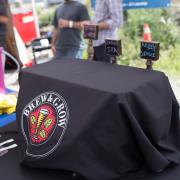With our newfound lager capacity is coming newfound interest in lagers. Lagers are my primary area of interest for both brewing and drinking, I though I might help encourage newer Brewers who may be hesitant and help de-mystify lager brewing a bit. Feel free to chime in with other tips or questions. These are just my tips based on our equipment, not intended as a be all-end all of lager brewing, just things I've picked up by experience that may help someone interested to try a lager.
1. Plan for heavy losses. One of the hallmarks of a great lager is clarity, to ease that process it's best to plan for heavy losses at every step in the process. Leave that extra inch in the boil kettle so you don't put as much trub in the fermenter, leave that extra inch or clear wort in the fermenter so you don't put all that trub in the secondary and so on. It sucks, but if you want a crystal clear lager, doing that really helps. Or buy a filter...
2. 90 minute boil always. I don't have the numbers in front of me but something like 30% of DMS (creamed corn) precursors are boiled off after 60 min. That jumps to like 90% at 90 min.
3. Sanitize, sanitize, sanitize!!! Your beer is gonna be sitting a while, plenty of time to go sour if you weren't clean. It sucks to wait 2 months for a bad beer.
4. This opinion is actually 2 opinions and is based partially on conversations with the 6th generation Brewmaster of Hirter Brewery. Pick one yeast and stick to it, and I vastly prefer dry yeast. By a lot. A LOT!!! Lager yeast is a mutant and there just aren't a whole lot of variations on it like ale yeast, it's just not genetically possible. Hirter uses one yeast for all their beers, from pilsners to doppelbocks the only thing that changes is the pitching rate. For home brewers, use Mrmalty.com to figure out your pitching rate, I like dry yeast because I'm busy. I can buy 2 packets and toss them in. I don't even rehydrate, toss them in, aerate, done. This helps me not have to spend all week stepping up a starter and I don't have to water down my beer with a 3 liter starter. If you want to go liquid and do starters go ahead, I'm just saying what works for me. Saflager 34/70 dry yeast is the Wiehenstephaner strain, it doesn't get much better than that, or easier.
5. Don't be afraid of simplicity in your grain bill, buy really good grain and let the quality of your ingredients and your technique speak for itself. With lagers it's harder to cover up bad technique and sanitation, etc. with a pinch of this caramel malt and dash of that malt, etc. just buy great ingredients and plan really really well. Do your prep work and it will pay off with an easier brew day and a better beer.
If I think of more I'll add them later. I hope this encourages you to brew a lager. Just plan well and let it all fall into place. It's easy, and delicious!!










I will put in tip 6.
The professional brewers call this method "krausening", but the term isn't really applicable on the non-professional scale since it requires multiople large batches of fermenting lager at high krausen.
So I use a modified method that I like to call "biomass injection".
Basically, after your lager is done with primary fermentation at around 50 degrees, unless you're really careful with temperature timings, the yeast has the possibility to go dormant. Not exactly what you want when your lager still has diacetyl and acetaldehyde.
What I do is I make a "starter" solution along with some hops (since much of your hop oils are going to flocc out with your lager yeast). Once it's cooled, throw it and a fresh smack pack of yeast into your soon-to-be-diacetyl-rested lager. The injection of fresh yeast cells and sugar aids in reduction of diacetyl, acetaldehyde, and produces some additional competition against other microbes. The CO2 production will also scrub out some of the residual sulfur aromas. Throwing in another addition of hops will also replace some of those that have fallen out onto the yeast cake and will mask the off-flavors.
Let the whole shebang go for 5 days + 2 days diacetyl rest, then cold crash and rack it off the yeast cake.
If you are die-hard about it, you will have to take this biomass injection into account when calculating alcohol.
For more reading on why/how this works:
http://byo.com/mead/item/966-kr%C3%A4usening-techniques
And why healthy yeast helps reduce acetaldehyde:
https://byo.com/mead/item/630-fermentation--flavor-compounds-homebrew-sc...